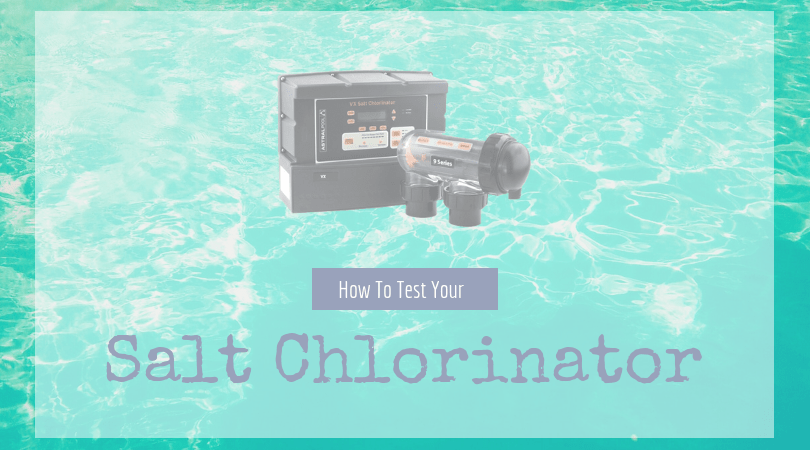Salt Chlorinator Troubleshooting
Salt Water Chlorinators will require periodic maintenance and repair to maintain optimum performance levels. Eventually the salt cell will lose performance and if left unattended, the controller circuit boards can develop problems as well.
This new article, I go through everything you need to know about testing your inefficient salt chlorinator.

Most salt cells should last 3-5 years, depending on the pool filtration system, and environmental factors. Good quality salt chlorinators have advanced control boards which can last up to 15 years (considering you maintain the salt cell).
Salt water chlorinators (also known as a salt cell) uses electrolysis in the presence of dissolved salt to produce hypochlorous acid and sodium hypochlorite, which are the sanitising agents used in swimming pools.
Typically, there are 3 key reasons why a salt water chlorinator will not work efficiently, thus leading to poor sanitation:
- Low Salt Levels
- High Calcium Levels
- Chlorine Levels
Low Salt levels
It is very important to understand that running your chlorinator without having enough salt in the water will cause damage to your electrodes so it’s the first point we advise to test and inspect for.
Your pool manufacture and salt chlorinator supplier will have guides available to provide you with the correct salt levels for your specific pool. Salt levels will range differently for the size of your pool, and in some cases the type of salt chlorinator.
You have two options to check salt levels; either check the salt levels on your own making use of screening test strips readily available from your local pool shop or take a water sample to your local pool shop such as Trojan Pool Services.
Our shops have trained personnel that will test your pool water and advise on the quantity of salt you require.
Our team will also offer you advice and instructions on the various other chemical balance elements which will impact the efficiency of your salt water chlorinator such as pH, chlorine stabiliser, calcium and alkalinity.
High Calcium Levels
Calcium deposits on the salt cell electrodes will greatly decrease the operating efficiency of your salt chlorinator.
Scale deposits can form along the waterline of your swimming pool. This is usually caused by either high pH, high alkalinity, or a high calcium concentration.
Constant temperature changes along with rapid evaporation will cause deposits to settle along the side your pool wall.
If your pool water test shows high levels of calcium, there may be a buildup of calcium on the cells themselves.
Simply check the cell visually to see if the is any scaling.
Should there be any signs of calcium build up, your next steps will be to clean the cell or consider replacing the salt chlorinator unit.
Failing to clean the cell will lead to further deterioration resulting in permanent damage.
Cells can be cleaned in a watered down solution of hydrochloric acid.
Please read the warnings and instructions on the acid container.
Typically you will make the acid solution with 1 part hydrochloric acid to 4 parts water in a suitable container.
Make sure your salt chlorinator unit is turned off so that any AutoMode functions can not turn it back on until after the cell is clean and back in its housing.
You will need to remove the cell from its housing and immerse in the acid solution.
This process should not take longer than a few minutes to clean.
Never use a stiff brush or hard implement to clean the cell because this will damage the coating.
Always follow the directions of the salt chlorinator manufacture.
Chlorine Levels
During the warmer months, free chlorine levels will fluctuate greatly. Depending on the weather from day to day, the chlorine level can drop by up to 90%.
Other factors that can influence chlorine levels is the pool filtration and sanitisation cycle duration, frequency of use, number of people etc.
It is recommended your pump run time is sufficient to turn over the volume of water twice per day.
Consider calculating your pool water volume and pump flow rate to determine the required cycle time duration. You may need to increase the pump cycle run time or increase the chlorine output
Most reputable salt chlorinators have adjustable settings, and you may find all that’s required is to have the chlorine level setting increased.
Ensure you check the chlorine levels frequently or at least once per week.
Other simple though overlooked symptoms are:
Check Power – If your salt chlorinator is plugged into an earth leakage outlet, make sure that the test button is not popped, or tripped. Most salt chlorinators will have lights and displays which would indicate power.
Water Flow – Insufficient water flow from dirty skimmer box baskets, clogged filter cartridge or clogged pump strainer can reduce water flow to such a low point, that very little chlorine is produced.
To Repair or Replace?
Well, they’re our troubleshooting tips for your salt water chlorinator.
The next step might be to assess the likely parts needed to repair the salt system vs the cost of a new salt chlorinator.
Here at Trojan Pool Services, you will enjoy the features and benefits available on our newest salt chlorinator systems for Gold Coast pools.
Frustrated by continually testing, adding chemicals and trying to keep your pool clear all the time?
We cut out all the fluff and confusion of pool maintenance and provide Gold Coast residents with pool servicing and advice
Using our computerised water testing equipment, we’ll give you a fast, accurate diagnosis about the condition of your pool water and prescribe exactly what your pool needs to keep it in great condition.

